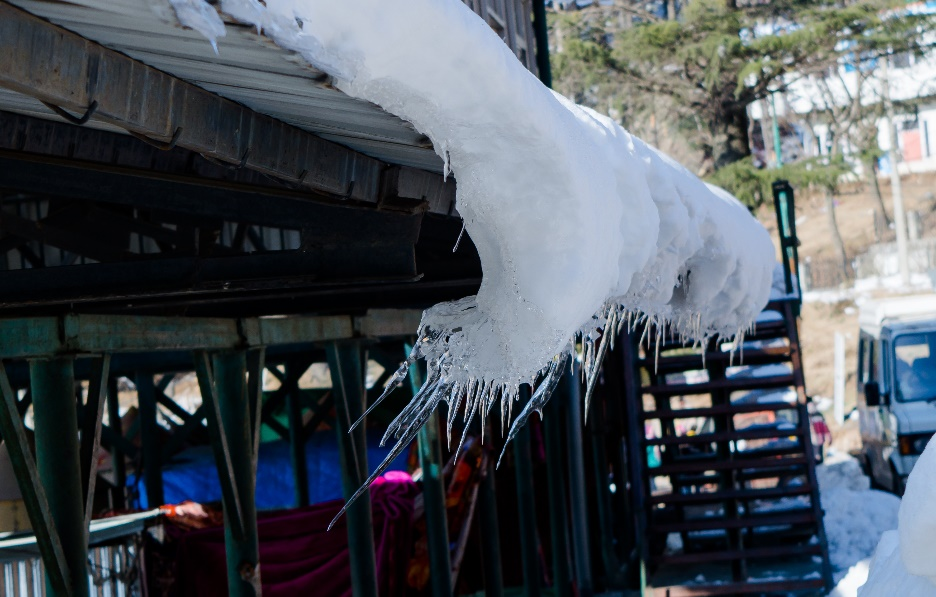Few household calamities can match the catastrophic effects caused by ice damming. Unchecked, ice dams can cause enormous damage to one’s home. These potentially disastrous effects range from severe damage to your roof, ceilings and walls, to structural issues. Unfortunately, one rarely even knows there is a problem until the damage is done. Preventing ice dams needs to be a homeowner’s priority, and roof heating cables are one of the best ways to prevent ice dams.
What are Ice Dams?
In the days and weeks following a snowstorm, the snow accumulated on the roof is warmed by the heat below and melts. Before this melted snow has a chance to run off the roof, cold temperatures cause it to refreeze, often near the edge and over the eaves. As this freeze-thaw cycle repeats itself throughout a long winter, a thick barrier of ice can form along the roof’s overhang, creating a dam. As subsequent melted snow collects and puddles behind the dam, this trapped standing water then finds its way below your shingles, leading to leaks and expensive damage. Infiltrating water can destroy your home’s insulation, seep into drywall, damage your attic and electrical systems and even cause mould.
What Are Roof Heating Cables?
Roof heating cables, sometimes known as de-icing cables, are insulated electric heating wires designed for roofs and gutters. The heat they give off prevents melting snow from refreezing before making its way off your roof. The heat prevents ice build-ups and, subsequently, ice damming from occurring.
How Roof Heating Cables Help
Since you’re unlikely to know if a roof dam has formed before it’s too late, the key is to prevent them from forming in the first place. That’s where roof heating cables can help. Roof heating cables are installed over the eaves, and in the gutters and downpipes of your home, and these cables produce heat that prevents the melted snow from refreezing before it runs off the roof.
When to Use Roof Heating Cables
While some newly constructed homes do not need roof heating cables, they are recommended for those living in older homes with poorly ventilated roofs, poor roof insulation, or any building that experiences frequent ice buildup. Ice dams are commonly formed on low-angled roofs, around chimneys and skylights, in roof valleys, and often at the roof’s eaves. Hanging icicles, damaged eavestroughs, and visible ice indicate that your home’s roof may be experiencing ice damming. If you notice these signs, you should call an electrician to have a de-icing system installed right away.
Roof Heating Cable Installation
While not a large job, correct placement and wiring are essential, which is why roof heating cable installation is one of those tasks best left in the hands of a licensed electrician. The performance and longevity of these systems rely on proper installation by an experienced professional. In addition to installing the cables, you’ll likely need a GFCI outlet installed near your roof, as well as a permit from the ESA if a circuit is installed to carry the load of the de-icing cables. Factors your installer will consider are the shape of your roof, type of roofing material, the solar orientation of your home, and the prevailing wind direction.
Once your roof heating cables have been installed, you can consider them a long-term feature; removal in the spring is unnecessary, and these cables require no maintenance.
How Long Can I Leave Heating Cables On?
How long your roof heating cables will be turned on will depend on various factors, including the average outdoor temperature, snow accumulation, and the condition of your roof and gutters. The good news is that the water only needs a drainage pathway to the ground through the ice, so a bit of heating goes a long way towards preventing costly damage to your home. Heating cables are generally self-regulating and controlled by a thermostat, so they don’t need to be manually turned on or off. They will automatically run for a couple of days after a storm until most snow and ice accumulation has melted away, so once they’ve been installed, you can forget about them and let them do their work!
Roof heating cables are a smart idea to help prevent significant damage to your home caused by ice damming. A licensed electrician has the experience and skills needed to complete the job correctly, ensuring excellent results to keep your home safe all winter long.
Talk to Toronto’s trusted team of electricians at AC Electrical to discover how Roof Cables can make winter’s wrath a little easier on your home!



